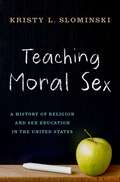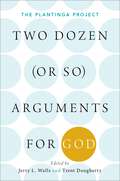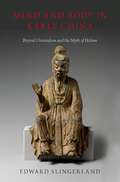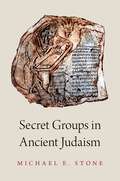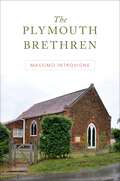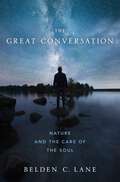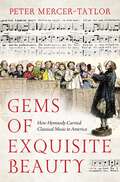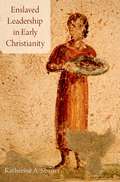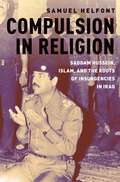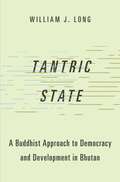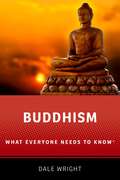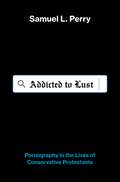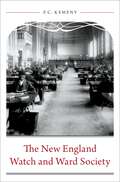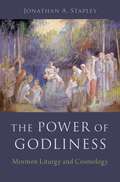- Table View
- List View
Teaching Moral Sex: A History of Religion and Sex Education in the United States
by Kristy L. SlominskiWhose job is it to teach the public about sex? Parents? The churches? The schools? And what should they be taught? These questions have sparked some of the most heated political debates in recent American history, most recently the battle between proponents of comprehensive sex education and those in favor of an "abstinence-only" curriculum. Kristy Slominski shows that these questions have a long, complex, and surprising history. Teaching Moral Sex is the first comprehensive study of the role of religion in the history of public sex education in the United States. The field of sex education, Slominski shows, was created through a collaboration between religious sex educators-primarily liberal Protestants, along with some Catholics and Reform Jews-and "men of science"-namely physicians, biology professors, and social scientists. She argues that the work of early religious sex educators laid the foundation for both sides of contemporary controversies that are now often treated as disputes between "religious" and "secular" Americans. Slominski examines the religious contributions to national sex education organizations from the late nineteenth century to the early twenty-first. Far from being a barrier to sex education, she demonstrates, religion has been deeply embedded in the history of sex education, and its legacy has shaped the terms of current debates. Focusing on religion uncovers an under-recognized cast of characters-including Quaker and Unitarian social purity reformers, military chaplains, and the Young Men's Christian Association- who, Slominski deftly shows, worked to make sex education more acceptable to the public through a strategic combination of progressive and restrictive approaches to sexuality. Teaching Moral Sex highlights the essential contributions of religious actors to the movement for sex education in the United States and reveals where their influence can still be felt today.
Two Dozen (or so) Arguments for God: The Plantinga Project
Thirty years ago, Alvin Plantinga gave a lecture called "Two Dozen (or so) Theistic Arguments," which served as an underground inspiration for two generations of scholars and students. In it, he proposed a number of novel and creative arguments for the existence of God which have yet to receive the attention they deserve. In Two Dozen (or so) Arguments for God, each of Plantinga's original suggestions, many of which he only briefly sketched, is developed in detail by a wide variety of accomplished scholars. The authors look to metaphysics, epistemology, semantics, ethics, aesthetics, and beyond, finding evidence for God in almost every dimension of reality. Those arguments new to natural theology are more fully developed, and well-known arguments are given new life. Not only does this collection present ground-breaking research, but it lays the foundations for research projects for years to come.
TWO DOZEN OR SO ARGUMENTS FOR GOD C: The Plantinga Project
by L. Walls and Trent DoughertyThirty years ago, Alvin Plantinga gave a lecture called "Two Dozen (or so) Theistic Arguments," which served as an underground inspiration for two generations of scholars and students. In it, he proposed a number of novel and creative arguments for the existence of God which have yet to receive the attention they deserve. In Two Dozen (or so) Arguments for God, each of Plantinga's original suggestions, many of which he only briefly sketched, is developed in detail by a wide variety of accomplished scholars. The authors look to metaphysics, epistemology, semantics, ethics, aesthetics, and beyond, finding evidence for God in almost every dimension of reality. Those arguments new to natural theology are more fully developed, and well-known arguments are given new life. Not only does this collection present ground-breaking research, but it lays the foundations for research projects for years to come.
Mind and Body in Early China: Beyond Orientalism and the Myth of Holism
by Edward SlingerlandMind and Body in Early China critiques Orientalist accounts of early China as the radical, "holistic" other. The idea that the early Chinese held the "strong" holist view, seeing no qualitative difference between mind and body, has long been contradicted by traditional archeological and qualitative textual evidence. New digital humanities methods, along with basic knowledge about human cognition, now make this position untenable. A large body of empirical evidence suggests that "weak" mind-body dualism is a psychological universal, and that human sociality would be fundamentally impossible without it. Edward Slingerland argues that the humanities need to move beyond social constructivist views of culture, and embrace instead a view of human cognition and culture that integrates the sciences and the humanities. Our interpretation of texts and artifacts from the past and from other cultures should be constrained by what we know about the species-specific, embodied commonalities shared by all humans. This book also attempts to broaden the scope of humanistic methodologies by employing team-based qualitative coding and computer-aided "distant reading" of texts, while also drawing upon our current best understanding of human cognition to transform our basic starting point. It has implications for anyone interested in comparative religion, early China, cultural studies, digital humanities, or science-humanities integration.
Mind and Body in Early China: Beyond Orientalism and the Myth of Holism
by Edward SlingerlandMind and Body in Early China critiques Orientalist accounts of early China as the radical, "holistic" other. The idea that the early Chinese held the "strong" holist view, seeing no qualitative difference between mind and body, has long been contradicted by traditional archeological and qualitative textual evidence. New digital humanities methods, along with basic knowledge about human cognition, now make this position untenable. A large body of empirical evidence suggests that "weak" mind-body dualism is a psychological universal, and that human sociality would be fundamentally impossible without it. Edward Slingerland argues that the humanities need to move beyond social constructivist views of culture, and embrace instead a view of human cognition and culture that integrates the sciences and the humanities. Our interpretation of texts and artifacts from the past and from other cultures should be constrained by what we know about the species-specific, embodied commonalities shared by all humans. This book also attempts to broaden the scope of humanistic methodologies by employing team-based qualitative coding and computer-aided "distant reading" of texts, while also drawing upon our current best understanding of human cognition to transform our basic starting point. It has implications for anyone interested in comparative religion, early China, cultural studies, digital humanities, or science-humanities integration.
Secret Groups in Ancient Judaism
by Michael StoneWere there groups in Ancient Judaism that cultivated esoteric knowledge and transmitted it secretly? With the discovery and burgeoning study of the Dead Sea Scrolls and particularly of the documents legislating the social structure of the Qumran group, the foremost paradigm for analysis of the group's social structure has become the "sect." This is still dominant, having replacing the monastic paradigm used by some of the earliest scholars of the Scrolls. But after studying what has been written on secret societies more generally, Michael Stone has concluded that many known ancient Jewish groups-the Qumran covenanters, Josephus's and Philo's Essenes, and Philo's Therapeutae-should be viewed as societies at the heart of whose existence were esoteric knowledge and practice. Guarding and transmitting this esoteric knowledge and practice, Stone argues, provided the dynamic that motivated the social and conceptual structure of these groups. Analyzing them as secret societies, he says, enables us to see previously latent social structural dimensions, and provides many new enriching insights into the groups, including the Dead Sea covenanters. By examining historical and literary sources, Stone uncovers evidence for the existence of other secret groups in ancient Jewish society. This line of study leads Stone not only to consider the "classical" Jewish apocalypses as pseudo-esoteric, but also to discern in them the footsteps of hidden, truly esoteric traditions cultivated in the circles that produced the apocalypses. This discovery has significant implications, especially considering the enormous growth of study of the apocalyptic in the Judaism of the Second Temple period and in nascent Christianity over the last seventy years.
Secret Groups in Ancient Judaism
by Michael StoneWere there groups in Ancient Judaism that cultivated esoteric knowledge and transmitted it secretly? With the discovery and burgeoning study of the Dead Sea Scrolls and particularly of the documents legislating the social structure of the Qumran group, the foremost paradigm for analysis of the group's social structure has become the "sect." This is still dominant, having replacing the monastic paradigm used by some of the earliest scholars of the Scrolls. But after studying what has been written on secret societies more generally, Michael Stone has concluded that many known ancient Jewish groups-the Qumran covenanters, Josephus's and Philo's Essenes, and Philo's Therapeutae-should be viewed as societies at the heart of whose existence were esoteric knowledge and practice. Guarding and transmitting this esoteric knowledge and practice, Stone argues, provided the dynamic that motivated the social and conceptual structure of these groups. Analyzing them as secret societies, he says, enables us to see previously latent social structural dimensions, and provides many new enriching insights into the groups, including the Dead Sea covenanters. By examining historical and literary sources, Stone uncovers evidence for the existence of other secret groups in ancient Jewish society. This line of study leads Stone not only to consider the "classical" Jewish apocalypses as pseudo-esoteric, but also to discern in them the footsteps of hidden, truly esoteric traditions cultivated in the circles that produced the apocalypses. This discovery has significant implications, especially considering the enormous growth of study of the apocalyptic in the Judaism of the Second Temple period and in nascent Christianity over the last seventy years.
The Plymouth Brethren
by Massimo IntrovigneThis is the first history of the Plymouth Brethren, a conservative, nonconformist evangelical Christian movement whose history can be traced to Dublin, Ireland in the late 1820s. The teachings of John Nelson Darby, an influential figure among the early Plymouth Brethren, have had a huge impact on modern evangelicalism. However, the credit for Darby's work went to some of the first generation of his students, and as evangelicalism has grown it has completely ignored its origins in Darby and the Brethren. In this book, Massimo Introvigne restores credit to John Nelson Darby and his movement, and places them in a contemporary sociological framework based on Introvigne's participant observation in Brethren communities. The modern-day Plymouth Brethren emphasize sola scriptura, the belief that the Bible is the supreme authority for church doctrine and practice. Brethren see themselves as a network of like-minded independent assemblies rather than as a church or a denomination. The movement has also refused to take any formal denominational name; the title "the Brethren" comes from the Biblical passage "one is your Master, even Christ; and all ye are brethren" (Matthew 23:8). The Plymouth Brethren offers a typology of differing branches of this reclusive movement, including a case study of the "exclusive" branch known as the Plymouth Brethren Christian Church, and reveals the various ways in which Brethren ideas have permeated the modern Christian world.
The Plymouth Brethren
by Massimo IntrovigneThis is the first history of the Plymouth Brethren, a conservative, nonconformist evangelical Christian movement whose history can be traced to Dublin, Ireland in the late 1820s. The teachings of John Nelson Darby, an influential figure among the early Plymouth Brethren, have had a huge impact on modern evangelicalism. However, the credit for Darby's work went to some of the first generation of his students, and as evangelicalism has grown it has completely ignored its origins in Darby and the Brethren. In this book, Massimo Introvigne restores credit to John Nelson Darby and his movement, and places them in a contemporary sociological framework based on Introvigne's participant observation in Brethren communities. The modern-day Plymouth Brethren emphasize sola scriptura, the belief that the Bible is the supreme authority for church doctrine and practice. Brethren see themselves as a network of like-minded independent assemblies rather than as a church or a denomination. The movement has also refused to take any formal denominational name; the title "the Brethren" comes from the Biblical passage "one is your Master, even Christ; and all ye are brethren" (Matthew 23:8). The Plymouth Brethren offers a typology of differing branches of this reclusive movement, including a case study of the "exclusive" branch known as the Plymouth Brethren Christian Church, and reveals the various ways in which Brethren ideas have permeated the modern Christian world.
The Great Conversation: Nature and the Care of the Soul
by Belden C. Lane"We are surrounded by a world that talks, but we don't listen. We are part of a community engaged in a vast conversation, but we deny our role in it." In the face of climate change, species loss, and vast environmental destruction, the ability to stand in the flow of the great conversation of all creatures and the earth can feel utterly lost to the human race. But Belden C. Lane suggests that it can and must be recovered, not only for the sake of endangered species and the well-being of at-risk communities, but for the survival of the world itself. The Great Conversation is Lane's multi-faceted treatise on a spiritually centered environmentalism. At the core is a belief in the power of the natural world to act as teacher. In a series of personal anecdotes, Lane pairs his own experiences in the wild with the writings of saints and sages from a wide range of religious traditions. A night in a Missourian cave brings to mind the Spiritual Exercises of Ignatius of Loyola; the canyons of southern Utah elicit a response from the Chinese philosopher Laozi; 500,000 migrating sandhill cranes rest in Nebraska and evoke the Sufi poet Farid ud-Din Attar. With each chapter, the humility of spiritual masters through the ages melds with the author's encounters with natural teachers to offer guidance for entering once more into a conversation with the world.
The Great Conversation: Nature and the Care of the Soul
by Belden C. Lane"We are surrounded by a world that talks, but we don't listen. We are part of a community engaged in a vast conversation, but we deny our role in it." In the face of climate change, species loss, and vast environmental destruction, the ability to stand in the flow of the great conversation of all creatures and the earth can feel utterly lost to the human race. But Belden C. Lane suggests that it can and must be recovered, not only for the sake of endangered species and the well-being of at-risk communities, but for the survival of the world itself. The Great Conversation is Lane's multi-faceted treatise on a spiritually centered environmentalism. At the core is a belief in the power of the natural world to act as teacher. In a series of personal anecdotes, Lane pairs his own experiences in the wild with the writings of saints and sages from a wide range of religious traditions. A night in a Missourian cave brings to mind the Spiritual Exercises of Ignatius of Loyola; the canyons of southern Utah elicit a response from the Chinese philosopher Laozi; 500,000 migrating sandhill cranes rest in Nebraska and evoke the Sufi poet Farid ud-Din Attar. With each chapter, the humility of spiritual masters through the ages melds with the author's encounters with natural teachers to offer guidance for entering once more into a conversation with the world.
Gems of Exquisite Beauty: How Hymnody Carried Classical Music to America
by Peter Mercer-TaylorIn the decades leading up to the Civil War, most Americans probably encountered European classical music primarily through hymn tunes. Hymnody was the most popular and commercially successful genre of the antebellum period in the United States, and the unquenchable thirst for new tunes to sing led to a phenomenon largely forgotten today: in their search for fresh material, editors lifted hundreds of tunes from the works of major classical composers to use as settings of psalms and hymns. The few that remain popular today millions have sung "Joyful, Joyful We Adore Thee" to Beethoven and "Hark, The Herald Angels Sing" to Mendelssohn are vestiges of one of the most distinctive trends in antebellum music-making. Gems of Exquisite Beauty is the first in-depth study of the historical rise and fall of this adaptation practice, its artistic achievements, and its place in nineteenth-century American musical life. It traces the contributions of pioneering figures like Arthur Clifton and the impact of bestsellers like the Handel and Haydn Society Collection, which helped turn Lowell Mason into America's most influential musician. By telling the tales of these hymns and those who brought them into the world, author Peter Mercer-Taylor reveals a central part of the history of how the American public first came to meet and creatively engage with Europe's rich musical practices.
Gems of Exquisite Beauty: How Hymnody Carried Classical Music to America
by Peter Mercer-TaylorIn the decades leading up to the Civil War, most Americans probably encountered European classical music primarily through hymn tunes. Hymnody was the most popular and commercially successful genre of the antebellum period in the United States, and the unquenchable thirst for new tunes to sing led to a phenomenon largely forgotten today: in their search for fresh material, editors lifted hundreds of tunes from the works of major classical composers to use as settings of psalms and hymns. The few that remain popular today millions have sung "Joyful, Joyful We Adore Thee" to Beethoven and "Hark, The Herald Angels Sing" to Mendelssohn are vestiges of one of the most distinctive trends in antebellum music-making. Gems of Exquisite Beauty is the first in-depth study of the historical rise and fall of this adaptation practice, its artistic achievements, and its place in nineteenth-century American musical life. It traces the contributions of pioneering figures like Arthur Clifton and the impact of bestsellers like the Handel and Haydn Society Collection, which helped turn Lowell Mason into America's most influential musician. By telling the tales of these hymns and those who brought them into the world, author Peter Mercer-Taylor reveals a central part of the history of how the American public first came to meet and creatively engage with Europe's rich musical practices.
Enslaved Leadership in Early Christianity
by Dr. Katherine A. ShanerEnslaved persons were ubiquitous in the first- and second-century CE Roman Empire, and early Christian texts reflect this fact. Yet the implications of enslaved presence in religious practices are under-examined in early Christian and Roman history. Enslaved Leadership in Early Christianity argues that enslaved persons' roles in civic and religious activities were contested in many religious groups throughout ancient cities, including communities connected with Paul's legacy. This power struggle emerges as the book examines urban spaces, inscriptions, images, and literature from ancient Ephesos and its environs. Enslaved Leadership breaks new ground in analyzing archaeology and texts-asking how each attempts to persuade viewers, readers, and inhabitants of the city. Thus this book paints a complex picture of enslaved life in Asia Minor, a picture that illustrates how enslaved persons enacted roles of religious and civic significance that potentially upended social hierarchies privileging wealthy, slave-holding men. Enslaved persons were religious specialists, priests, and leaders in cultic groups, including early Christian groups. Yet even as the enslaved engaged in such authoritative roles, Roman slavery was not a benign institution nor were all early Christians kinder and more egalitarian to slaves. Both early Christian texts (such as Philemon,1 Timothy, Ignatius' letters) and the archaeological finds from Asia Minor defend, construct, and clarify the hierarchies that kept enslaved persons under the control of their masters. Enslaved Leadership illustrates a historical world in which control of slaves must continually be asserted. Yet this assertion of control raises a question: Why does enslaved subordination need to be so frequently re-established, particularly through violence, the threat of social death, and assertions of subordination?
COMPULSION IN RELIGION C: Saddam Hussein, Islam, and the Roots of Insurgencies in Iraq
by Samuel HelfontSamuel Helfont draws on extensive research with Ba'thist archives to investigate the roots of the religious insurgencies that erupted in Iraq following the American-led invasion in 2003. In looking at Saddam Hussein's policies in the 1990s, many have interpreted his support for state-sponsored religion as evidence of a dramatic shift away from Arab nationalism toward political Islam. While Islam did play a greater role in the regime's symbols and Saddam's statements in the 1990s than it had in earlier decades, the regime's internal documents challenge this theory. The "Faith Campaign" Saddam launched during this period was the culmination of a plan to use religion for political ends, begun upon his assumption of the Iraqi presidency in 1979. At this time, Saddam began constructing the institutional capacity to control and monitor Iraqi religious institutions. The resulting authoritarian structures allowed him to employ Islamic symbols and rhetoric in public policy, but in a controlled manner. Saddam ultimately promoted a Ba'thist interpretation of religion that subordinated it to Arab nationalism, rather than depicting it as an independent or primary political identity. The point of this examination of Iraqi history, other than to correct the current understanding of Saddam Hussein's political use of religion throughout his presidency, is to examine how Saddam's controlled use of religion was dismantled during the US-Iraq war, and consequently set free extremists that were suppressed under his regime. When the American-led invasion destroyed the regime's authoritarian structures, it unwittingly unhinged the forces that these structures were designed to contain, creating an atmosphere infused with religion, but lacking the checks provided by the former regime. Groups such as the Sadrists, al-Qaida, and eventually the Islamic State emerged out of this context to unleash the insurgencies that have plagued post-2003 Iraq.
Tantric State: A Buddhist Approach to Democracy and Development in Bhutan (Studies in Comparative Political Theory)
by William J. LongToday, the majority of sovereign states can be described as "democracies" because they possess elected political leadership and some measure of commitment to the protection and promotion of individual rights and equality under law. In the economic realm, most democracies are market-based and are integrated into wider regional and global markets. Virtually all are organized around Western liberal principles and values. For some, these philosophical commitments are indigenous and longstanding, and for others they were imported later, often through colonization. This book asks how democratic governance and economic development differ when founded on Eastern, Buddhist principles, rather than Western, liberal, and Enlightenment values and beliefs. The small, remote country of Bhutan is the only democratic, market-based state that is rooted constitutionally and culturally in Mahayana Buddhist principles and ethics. In this book, William J. Long provides an authentic basis for theoretical and empirical comparison between two distinct models of democracy and development that differ on important, first-order principles. Bhutanese Buddhist and Western liberal concepts of the individual "self," "human nature" and "the pursuit of happiness"-the building blocks of democratic and market-based economic theory-differ profoundly. Because the two approaches-liberal and Buddhist-are based on distinctive philosophical traditions, this comparison elucidates new questions, frames of inquiry, and alternative understandings of democracy and development. The book describes how democratic political institutions and markets emerged and how they function in Bhutan, demonstrating how, in real-world terms, Bhutan organizes and operates a political and economic system consistent with its Buddhist worldview. It considers the nature of Bhutan's unique political institutions and its economic touchstone, the pursuit of "Gross National Happiness (GNH)," rather than Gross National Product, as its ordering principle for policy. Ultimately, Tantric State reflects on whether Bhutan's unique model can withstand the forces of globalization and what insights Bhutan might have to share with the rest of us about dilemmas facing Western democracies and the need to pursue development in a more holistic and sustainable way.
Tantric State: A Buddhist Approach to Democracy and Development in Bhutan (Studies in Comparative Political Theory)
by William J. LongToday, the majority of sovereign states can be described as "democracies" because they possess elected political leadership and some measure of commitment to the protection and promotion of individual rights and equality under law. In the economic realm, most democracies are market-based and are integrated into wider regional and global markets. Virtually all are organized around Western liberal principles and values. For some, these philosophical commitments are indigenous and longstanding, and for others they were imported later, often through colonization. This book asks how democratic governance and economic development differ when founded on Eastern, Buddhist principles, rather than Western, liberal, and Enlightenment values and beliefs. The small, remote country of Bhutan is the only democratic, market-based state that is rooted constitutionally and culturally in Mahayana Buddhist principles and ethics. In this book, William J. Long provides an authentic basis for theoretical and empirical comparison between two distinct models of democracy and development that differ on important, first-order principles. Bhutanese Buddhist and Western liberal concepts of the individual "self," "human nature" and "the pursuit of happiness"-the building blocks of democratic and market-based economic theory-differ profoundly. Because the two approaches-liberal and Buddhist-are based on distinctive philosophical traditions, this comparison elucidates new questions, frames of inquiry, and alternative understandings of democracy and development. The book describes how democratic political institutions and markets emerged and how they function in Bhutan, demonstrating how, in real-world terms, Bhutan organizes and operates a political and economic system consistent with its Buddhist worldview. It considers the nature of Bhutan's unique political institutions and its economic touchstone, the pursuit of "Gross National Happiness (GNH)," rather than Gross National Product, as its ordering principle for policy. Ultimately, Tantric State reflects on whether Bhutan's unique model can withstand the forces of globalization and what insights Bhutan might have to share with the rest of us about dilemmas facing Western democracies and the need to pursue development in a more holistic and sustainable way.
Buddhism: What Everyone Needs to Know® (What Everyone Needs to Know)
by Dale S. WrightBuddhism is one of the oldest and largest of the world's religions. But it is also a tradition that has proven to have enormous contemporary relevance. Founded by Siddhartha Gautama, who came to be called the Buddha, the religion has spread from its origins in northeast India, across Asia, and eventually to the West, taking on new forms at each step of the way. Buddhism: What Everyone Needs to Know offers readers a brief, authoritative guide to one of the world's most diverse religious traditions in a reader-friendly question-and-answer format. Dale Wright covers the origins and early history of Buddhism, the diversity of types of Buddhism throughout history, and the status of contemporary Buddhism. This is a go-to book for anyone seeking a basic understanding of the origins, history, teachings, and practices of Buddhism.
BUDDHISM WENK C: What Everyone Needs to Know® (What Everyone Needs to Know)
by Dale S. WrightBuddhism is one of the oldest and largest of the world's religions. But it is also a tradition that has proven to have enormous contemporary relevance. Founded by Siddhartha Gautama, who came to be called the Buddha, the religion has spread from its origins in northeast India, across Asia, and eventually to the West, taking on new forms at each step of the way. Buddhism: What Everyone Needs to Know offers readers a brief, authoritative guide to one of the world's most diverse religious traditions in a reader-friendly question-and-answer format. Dale Wright covers the origins and early history of Buddhism, the diversity of types of Buddhism throughout history, and the status of contemporary Buddhism. This is a go-to book for anyone seeking a basic understanding of the origins, history, teachings, and practices of Buddhism.
Addicted to Lust: Pornography in the Lives of Conservative Protestants
by Samuel L. PerryFew cultural issues alarm conservative Protestant families and communities like the seemingly ubiquitous threat of pornography. Thanks to widespread access to the internet, conservative Protestants now face a reality in which every Christian man, woman, and child with a smartphone can access limitless pornography in their bathroom, at work, or at a friend's sleepover. Once confident of their victory over pornography in society at large, conservative Protestants now fear that "porn addiction" is consuming even the most faithful. How are they adjusting to this new reality? And what are its consequences in their lives? Drawing on over 130 interviews as well as numerous national surveys, Addicted to Lust shows that, compared to other Americans, pornography shapes the lives of conservative Protestants in ways that are uniquely damaging to their mental health, spiritual lives, and intimate relationships. Samuel L. Perry demonstrates how certain pervasive beliefs within the conservative Protestant subculture unwittingly create a context in which those who use pornography are often overwhelmed with shame and discouragement, sometimes to the point of depression or withdrawal from faith altogether. Conservative Protestant women who use pornography feel a "double shame" both for sinning sexually and for sinning "like a man," while conflicts over pornography in marriages are escalated by patterns of lying, hiding, blowing up, or threats of divorce. Addicted to Lust shines new light on one of the most talked-about problems facing conservative Christians.
Addicted to Lust: Pornography in the Lives of Conservative Protestants
by Samuel L. PerryFew cultural issues alarm conservative Protestant families and communities like the seemingly ubiquitous threat of pornography. Thanks to widespread access to the internet, conservative Protestants now face a reality in which every Christian man, woman, and child with a smartphone can access limitless pornography in their bathroom, at work, or at a friend's sleepover. Once confident of their victory over pornography in society at large, conservative Protestants now fear that "porn addiction" is consuming even the most faithful. How are they adjusting to this new reality? And what are its consequences in their lives? Drawing on over 130 interviews as well as numerous national surveys, Addicted to Lust shows that, compared to other Americans, pornography shapes the lives of conservative Protestants in ways that are uniquely damaging to their mental health, spiritual lives, and intimate relationships. Samuel L. Perry demonstrates how certain pervasive beliefs within the conservative Protestant subculture unwittingly create a context in which those who use pornography are often overwhelmed with shame and discouragement, sometimes to the point of depression or withdrawal from faith altogether. Conservative Protestant women who use pornography feel a "double shame" both for sinning sexually and for sinning "like a man," while conflicts over pornography in marriages are escalated by patterns of lying, hiding, blowing up, or threats of divorce. Addicted to Lust shines new light on one of the most talked-about problems facing conservative Christians.
The New England Watch and Ward Society
by P. C. KemenyThe New England Watch and Ward Society provides a new window into the history of the Protestant establishment's prominent role in late nineteenth-century public life and its confrontation with modernity, commercial culture, and cultural pluralism in early twentieth-century America. Elite liberal Protestants, typically considered progressive, urbane, and tolerant, established the Watch and Ward Society in 1878 to suppress literature they deemed obscene, notably including Walt Whitman's Leaves of Grass. These self-appointed custodians of Victorian culture enjoyed widespread support from many of New England's most renowned ministers, distinguished college presidents, respected social reformers, and wealthy philanthropists. In the 1880s, the Watch and Ward Society expanded its efforts to regulate public morality by attacking gambling and prostitution. The society not only expressed late nineteenth-century Victorian American values about what constituted "good literature," sexual morality, and public duty, it also embodied Protestants' efforts to promote these values in an increasingly intellectually and culturally diverse society. By 1930, the Watch and Ward Society had suffered a very public fall from grace. Following controversies over the suppression of H.L. Mencken's American Mercury as well as popular novels such as Sinclair Lewis' Elmer Gantry and D.H. Lawrence's Lady Chatterley's Lover, cultural modernists, civil libertarians, and publishers attacked the moral reform movement, ridiculing its leaders' privileged backgrounds, social idealism, and religious commitments. Their critique reshaped the dynamics of Protestant moral reform activity as well as public discourse in subsequent decades. For more than a generation, however, the Watch and Ward Society expressed mainline Protestant attitudes toward literature, gambling, and sexuality.
The New England Watch and Ward Society
by P. C. KemenyThe New England Watch and Ward Society provides a new window into the history of the Protestant establishment's prominent role in late nineteenth-century public life and its confrontation with modernity, commercial culture, and cultural pluralism in early twentieth-century America. Elite liberal Protestants, typically considered progressive, urbane, and tolerant, established the Watch and Ward Society in 1878 to suppress literature they deemed obscene, notably including Walt Whitman's Leaves of Grass. These self-appointed custodians of Victorian culture enjoyed widespread support from many of New England's most renowned ministers, distinguished college presidents, respected social reformers, and wealthy philanthropists. In the 1880s, the Watch and Ward Society expanded its efforts to regulate public morality by attacking gambling and prostitution. The society not only expressed late nineteenth-century Victorian American values about what constituted "good literature," sexual morality, and public duty, it also embodied Protestants' efforts to promote these values in an increasingly intellectually and culturally diverse society. By 1930, the Watch and Ward Society had suffered a very public fall from grace. Following controversies over the suppression of H.L. Mencken's American Mercury as well as popular novels such as Sinclair Lewis' Elmer Gantry and D.H. Lawrence's Lady Chatterley's Lover, cultural modernists, civil libertarians, and publishers attacked the moral reform movement, ridiculing its leaders' privileged backgrounds, social idealism, and religious commitments. Their critique reshaped the dynamics of Protestant moral reform activity as well as public discourse in subsequent decades. For more than a generation, however, the Watch and Ward Society expressed mainline Protestant attitudes toward literature, gambling, and sexuality.
The Power of Godliness: Mormon Liturgy and Cosmology
by Jonathan StapleyThe Power of Godliness is a key work to understand Mormon conceptions of priesthood, authority, and gender. With in-depth research and never previously used documents, Jonathan A. Stapley explores the rituals of ordination, temple "sealings," baby blessings, healing, and cunning-folk traditions. In doing so, he demonstrates that Mormon liturgy includes a much larger and more complex set of ritualized acts of worship than the specific rites of initiation, instruction, and sealing that take place within the temple walls. By exploring Mormonism's liturgy more broadly, The Power of Godliness shows both the nuances of Mormon belief and practice, and how the Mormon ordering of heaven and earth is not a mere philosophical or theological exercise. Stapley examines Mormonism's liturgical history to reveal a complete religious world, incorporating women, men, and children all participating in the construction of the Mormon universe. This book opens new possibilities for understanding the lived experiences of women and men in the Mormon past and present, and investigates what work these rituals and ritualized acts actually performed in the communities that carried them out. By tracing the development of the rituals and the work they accomplish, The Power of Godliness sheds important new light on the Mormon universe, its complex priesthoods, authorities, and powers.
POWER OF GODLINESS C: Mormon Liturgy and Cosmology
by Jonathan StapleyThe Power of Godliness is a key work to understand Mormon conceptions of priesthood, authority, and gender. With in-depth research and never previously used documents, Jonathan A. Stapley explores the rituals of ordination, temple "sealings," baby blessings, healing, and cunning-folk traditions. In doing so, he demonstrates that Mormon liturgy includes a much larger and more complex set of ritualized acts of worship than the specific rites of initiation, instruction, and sealing that take place within the temple walls. By exploring Mormonism's liturgy more broadly, The Power of Godliness shows both the nuances of Mormon belief and practice, and how the Mormon ordering of heaven and earth is not a mere philosophical or theological exercise. Stapley examines Mormonism's liturgical history to reveal a complete religious world, incorporating women, men, and children all participating in the construction of the Mormon universe. This book opens new possibilities for understanding the lived experiences of women and men in the Mormon past and present, and investigates what work these rituals and ritualized acts actually performed in the communities that carried them out. By tracing the development of the rituals and the work they accomplish, The Power of Godliness sheds important new light on the Mormon universe, its complex priesthoods, authorities, and powers.
